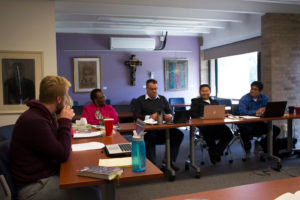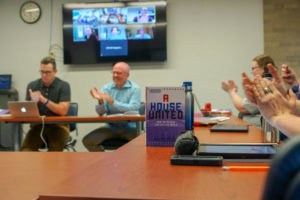By TESHA M. CHRISTENSEN
At a time when seminary students are seeking connection, flexibility, and community involvement, the United Theological Seminary has decided to move from the suburbs into the city.
Seminary representatives signed a lease in September for 25,000 square feet at the Case Building (767 N. Eustis St.), and work will start soon on the space.
Classes for the spring term will begin at the new campus on Jan. 14, 2019.
 Photo right: United Theological Seminary will be moving from New Brighton into the Towerside Innovation District and Creative Enterprise Zone in St. Paul. Classes are set to start in the former Case warehouse at 767 N. Eustice St. in January 2019, which is just a few blocks away from the Green Lightrail line on University. The new location also sits at the intersection of Highway 280 and Interstate 94. (Photo by Tesha M. Christensen)
Photo right: United Theological Seminary will be moving from New Brighton into the Towerside Innovation District and Creative Enterprise Zone in St. Paul. Classes are set to start in the former Case warehouse at 767 N. Eustice St. in January 2019, which is just a few blocks away from the Green Lightrail line on University. The new location also sits at the intersection of Highway 280 and Interstate 94. (Photo by Tesha M. Christensen)
 “Our new campus space will be designed to best serve seminary education of today where many students participate remotely and require state-of-the-art technology, and many in-residence students commute and prefer an urban setting with access to mass transit,” observed United Theological Seminary President Lee Zeidner (photo left provided).
“Our new campus space will be designed to best serve seminary education of today where many students participate remotely and require state-of-the-art technology, and many in-residence students commute and prefer an urban setting with access to mass transit,” observed United Theological Seminary President Lee Zeidner (photo left provided).
“It will be in a vibrant community surrounded by emerging arts and non-profit organizations with socially conscious missions—this will create opportunities for collaborative efforts and opportunities for students to be involved in a multitude of community efforts as part of their training.”
Global Academy, a pre-K-8th grade International Baccalaureate Charter School, has purchased the seminary’s former location in New Brighton.
A melting pot of faith
United Theological Seminary of the Twin Cities was founded in 1962 by the United Church of Christ as an ecumenical seminary serving all Protestant denominations. “Unlike other seminaries in the Cities that were single denomination focused (Lutheran, Baptist or Roman Catholic), United’s founders recognized the value of ecumenical training as families and communities became melting pots of faith traditions,” observed Zeidner.
United was started in New Brighton as the merging of two seminaries: Yankton Seminary in South Dakota and Mission House Seminary in Wisconsin. The land it was built on was originally a pig farm. In the 1980s, much of the land was sold off and became Seminary Estates, a community of single-family homes.
 Photo right: United Theological Seminary students in a typical class with examples of the school’s theological art collection in the background. (Photo submitted)
Photo right: United Theological Seminary students in a typical class with examples of the school’s theological art collection in the background. (Photo submitted)
The current campus in New Brighton consisted of about five acres with four buildings: the original classroom building that now includes an award-winning architectural chapel built about ten years ago, a library and dining building, an administrative building and the residence building.
United will continue to own and operate the residential units adjacent to the New Brighton campus and rent them to students. The seminary will provide subsidies for transportation from the residential units to the St. Paul campus for students that do not have access to cars.
Strong social justice bent
United has had a strong social justice bent throughout its existence, pointed out Zeidner, such as advocating for women in ministry 25 years ago when faith leadership was very male-dominated.
United has served many seminarians who have been historically marginalized by traditional church teachings, he added, and United’s work has evolved as societal challenges inside and outside of the church have similarly changed.
“More recently United has been on the front lines of advocating for the welcoming and affirming of gay and lesbian people in the church and now in ministry,” said Zeidner.
“Seminary was once a cloistered environment mostly serving white men on a path to church ministry—today it is a community-based model that serves a wide diversity of people on paths to serving people inside and outside the church in developing and exploring their spiritual lives,” remarked Zeidner.
 Photo left: United Seminary students learn alongside distance education students (on the screen in the background). (Photo submitted)
Photo left: United Seminary students learn alongside distance education students (on the screen in the background). (Photo submitted)
United has increased its focus on inter-religious chaplaincy —helping chaplains who will serve patients in hospitals, long-term care facilities, the military, and other settings to better understand and relate to people of all faith traditions, not just Christians.
“Deeply understanding intercultural and inter-religious wisdom can help our graduates better serve those who they are in service to,” remarked Zeidner.
This fall, there are about 100 students enrolled at United, 80% in masters programs and 20% in doctoral programs.
About 30% of students are people of color, and 47% of students identify themselves as female. Students come from across the United States, as well as from all continents and a multitude of countries outside of the U.S.
No denomination represents more than 20% of students. Students who define themselves as “none” (having no religious path in their background) represent nearly 10% of students.
A flexible space
The one-story, 180-000-sq-ft brick Case Building was built by the Case Corp. in 1948 as a tractor parts distribution warehouse. Suntide Commercial Realty initiated development of the 1940s structure in St. Paul’s Westgate industrial area. The area includes about six city blocks nestled into an area bounded by University Ave. to the north, Hwy. 280 to the east, Interstate 94 to the south and the Minneapolis border to the west.
The space is currently a large shell with structural characteristics including many skylights and an urban green space. United hired Doug Pierce, an architect from Perkins and Will, to design its new campus.
The design will include a beautiful chapel, flexible space for creative expression including visual and performing arts, a space for prayer and meditation for those of many faiths, a community dining area, large classrooms with state-of-the-art technology, a technologically modern library, multiple bright and engaging student huddle and study areas and a patio in an urban green space right outside. The city plans to transform an abandoned rail spur and bridge over Hwy. 280 into a bike-and-pedestrian trail connection running past the Case Building.
“Our new space is designed with input from students, alumni, faculty and staff and in that context will create an ideal learning culture for a diverse and vibrant seminary community,” commented Zeidner.
“The space is designed to be fully accessible, green and comfortable for our diverse student, faculty, and staff body.”
United’s move to the Towerside Innovation District and Creative Enterprise Zone will better support existing curricular offerings and make way for new educational models.
While coursework in the arts and theology, social justice, and interreligious competency have been optional up until now, starting fall 2019, they will be required. Technology infrastructure will support a growing base of distance education students.
Rev. Karen Hutt, vice president for student formation, vocation, and experience, plans to provide new places and contexts for United students to serve. “We’ve partnered with Episcopal Homes to support their spiritual development program through chaplaincy internships,” stated Hutt.
She continued, “Our partnership with Episcopal Homes is just one way our students are addressing the changing role of the church.
“People are lonely and in trouble everywhere—public spaces, clinics, libraries, correctional facilities, waiting rooms and human service organizations. These same people may not be going to church to talk to a minister, but they certainly benefit from talking to a chaplain or even a chaplain in training. This is what community and fellowship look like to our seminary students.”
The concept of church evolving
The concept of the church may be evolving, but the core needs of people are not going away, stated Zeidner.
“While much has been written about the diminishing perceived need for ‘church’ at the center of community life in modern society, the need for a spiritual life within the community is growing life,” said Zeidner. “A place to ask the big questions of life about the broader meanings of our lives and how we can live happier and more fulfilled lives in community with others are still important to many.”
He continued, “Despite the clouds of ambiguity about the future of faith communities, it seems clear that less will center on large buildings with steeples and stained glass.”
“More will require leaders who can bridge between the everyday experiences of people and historical contexts and texts in a manner that is perceived as relevant and useful,” Zeidner concluded. “More will require leaders who can lead from within the community rather than from raised pulpits with sage voices. Leaders will require strong interpersonal skills with egos that can tolerate conflict and ambiguity. More will require deep skills at meeting the spiritual and emotional needs of people.”
Comments
No comments on this item Please log in to comment by clicking here